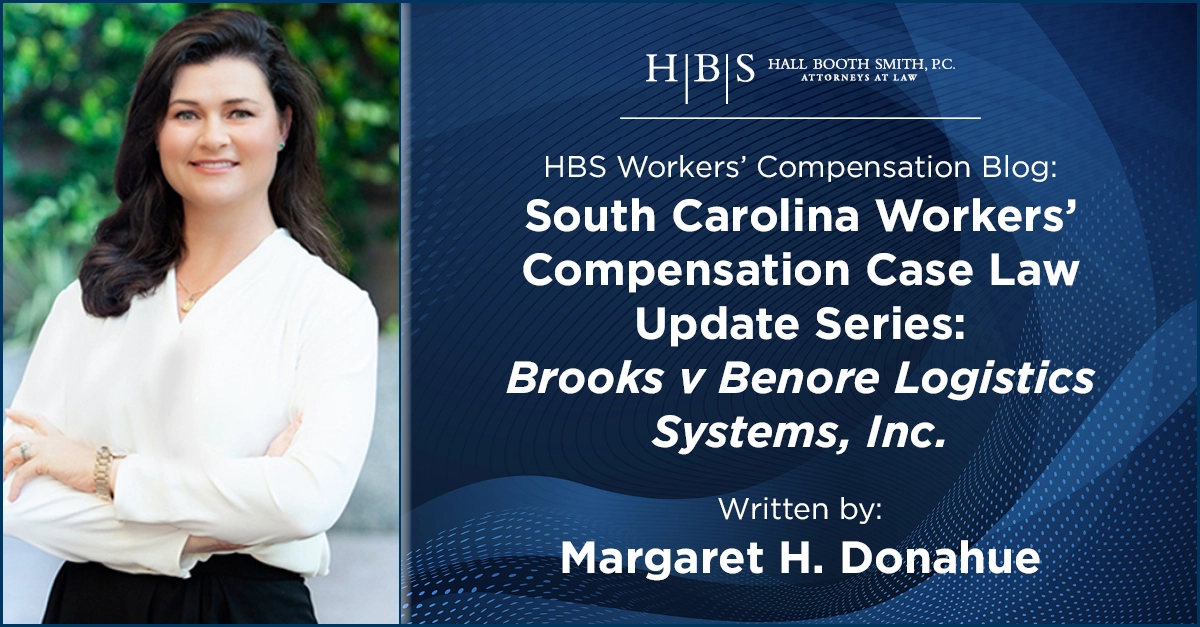
South Carolina Workers’ Compensation Case Law Update Series, Part I: Brooks v. Benore Logistics Systems, Inc.
Introduction
The South Carolina appellate courts have been faced with several questions on workers’ compensation in recent months, producing opinions that will affect practice points and claims handling in defending workers compensation claims. In this series, I’ll discuss the rulings and how Employers and Carriers should be mindful of this precedent going forward.
The Case
Brooks v. Benore Logistics Systems, Inc., SC Supreme Court, April 10, 2024
This case involves a repetitive trauma injury and role of an ergonomics evaluation, and ultimately directs how such an opinion is to be used meeting or defeating the burden of proof required by Section 42-1-172 for repetitive trauma injury. In boiling down the requirements of the repetitive trauma statute, the Court notes that a claimant is required to show, and the Commission make specific findings, that (1) the nature of the claimant’s work is repetitive; and (2) there is a causal link between the repetitive work and the claimant’s injury. The Court points out that it is less of a question of whether a job is repetitive, as many are, but whether the job is sufficiently repetitive to have caused the injury. (emphasis in the original).
The Court goes on the explain that, per the statute, the causal connection must be supported by “medical evidence”, and that the SC Workers’ Compensation Act defines medical evidence as that offered to a reasonable degree of medical certainty by a licensed and qualified medical physician. The pertinent evidence presented in this case included: an ergonomic evaluation presented by the defense in which a non-M.D. ergonomics expert opined that the job duties were “statistically unlikely” to cause the injury at issue; and a medical record and subsequent questionnaire in which the treating physician supported a causal relationship between the job duties and the injury, including answering that he reviewed the ergonomic opinion and it did not change his opinion on causation. The Court ruled that the ergonomics opinion was inadmissible as to causation because it did not meet the definition of “medical evidence” under the Act.
The ruling that a specialized expert’s opinion is “inadmissible” sounds extreme. But, in reading the Court’s rationale, it has not barred the use of ergonomics evaluations but defined for what purpose and how these opinions are to be used. Again, there are two steps in evaluating a claim for repetitive trauma injury. The purely factual aspect: whether a job is repetitive; for which the evidence does not have to be “medical”, just sufficient to form a factual basis. The ergonomic study in this particular case did not give an opinion that the job was not repetitive, and seemed to support that the job was repetitive on some scale. The crux of the opinion was only that the duties were statistically unlikely to cause the injury in question, which is offering an opinion on causation. And that is where the Court took issue with its use.
This case still leaves room for the defense to obtain an ergonomic study on the issue of whether a job is truly repetitive. For example, We’ve dealt with studies that clarify, though the employee is performing the same tasks daily and/or many times daily, the frequency with which they are repeated does not constitute “repetitive” from an ergonomic standpoint; some going into more detail describing that the muscle groups used in performing the task or series of tasks change often enough in the course of performance that the job is not truly repetitive from a biometric perspective. Thus, ergonomic studies can and will still be a valuable tool in repetitive trauma claims. On their own they can support a favorable finding on the first prong of the statute that a job is not “repetitive”.
For borderline circumstances, where the job sounds arguably repetitive, or in cases where a physician has endorsed causation based on the claimant’s description of the job alone, having a favorable ergonomic opinion can be useful in swaying the necessary physician opinion to defeat the causation requirement. The Court explains that in this case the ergonomics opinion was presented to the treating physician with the specific question as to whether the ergonomics report changed his opinion on causation. The physician disagreed. The Court effectively endorsed the use of an ergonomic study in the process of obtaining the medical evidence, in order to give the physician some context.
As the ergonomic study in this case did nothing to defeat the job being repetitive, it did not provide a defense to the first prong of Section 42-1-172. As it is was not the opinion of a licensed medical physician, and thus not medical evidence, it could not be used (and is inadmissible for the purpose of) solely to defeat medical evidence supporting causation.
Disclaimer
This material is provided for informational purposes only. It is not intended to constitute legal advice nor does it create a client-lawyer relationship between Hall Booth Smith, P.C. and any recipient. Recipients should consult with counsel before taking any actions based on the information contained within this material. This material may be considered attorney advertising in some jurisdictions. Prior results do not guarantee a similar outcome.
Blog Overview
About the Author
Margaret H. “Meg” Donahue
Of Counsel | Charleston Office
T: 803.730.3978
E: mdonahue@hallboothsmith.com
Charleston Of Counsel Margaret H. “Meg” Donahue represents employers and insurance carriers in coverage disputes, compensability, permanency disputes, medically complex cases, and toxic exposure in the workplace. She advises clients in defensive strategy, claim valuation, and mitigation of risk and loss.




Leave a comment
You must be logged in to post a comment.